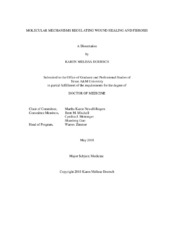| dc.description.abstract | Impaired wound healing and excess scarring are substantial clinical problems that affect millions of Americans annually and cost billions of dollars to treat. Currently there are insufficient therapies available to improve wound healing. Many patients without underlying comorbidities experience problematic wound healing every year. Additionally, certain diseases predispose individuals to excess scarring and poor healing. One such disease, Systemic Lupus Erythematosus (SLE), affects roughly one million Americans and leads to numerous skin pathologies, including excess scarring and wound healing delays. Interleukin-2 (IL-2), a cytokine that impacts the signaling of immune cells and may contribute to wound healing, is dysregulated in SLE. We hypothesized that IL-2 signaling acts as a growth factor for cutaneous wound healing but leads to scarring in SLE. We employed wound healing models in both wild-type (WT) and SLE-model mice and a fibroblast cell culture to study wound healing. Because fibrosis is a key contributor to impaired wound healing, especially in SLE, we employed an anti-fibrotic agent, quercetin, to determine whether blockade of fibrosis improves the quality of healed wounds in healthy and SLE-mode mice. We used Trichrome staining and flow cytometric analysis to understand quercetin’s impact on wounds. Additionally, immunohistochemistry (IHC) for IL-2 and IL-2-receptor-α (IL-2Rα) in wounds and flow cytometry of immune cells revealed how IL-2 signaling impacts wound healing in the SLE-model mice. Our findings indicate that the mechanism by which quercetin reduces fibrosis at the wound site may involve reduced expression of β1 integrin and increased αV integrin. However, a comparative analysis between the WT and the SLE-model mice demonstrated that quercetin impairs wound healing only in the SLE model. In the wounds of quercetin-treated SLE-model mice, there is also evidence of impaired IL-2 signaling. Paradoxically, we show that in cultured fibroblasts, combination treatment with quercetin and IL-2 increases IL-2R expression. To better understand the difference between the in vitro and in vivo studies, we demonstrate that quercetin alters immune cell signaling in the SLE-model mice, and that this reduces IL-2Rα at the wound site. Thus, by using quercetin to prevent fibrosis, we block an increase in IL-2 signaling that may be necessary for wound healing in SLE. More work is needed to better understand how IL-2 impacts wound healing and scar formation in patients with wounds with and without SLE. | en |


